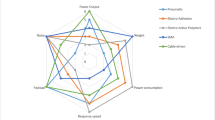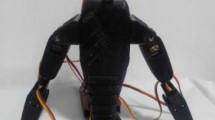Abstract
Directly self-adaptive under-actuated (DSUA) hands have great potential to stably grasp different objects in unstructured environments. This paper develops a DSUA Hand based on multi-pulley-belt mechanism, which consists of 5 fingers and has 14 DOF. Self-adaptation is designed as the main function of it. The stability of DSUA hand’s grasping process does not highly depend on control algorithm, sensors or control system. This DSUA fingers are based on multi-pulley-belt mechanism. A mathematical model of the 3-joint finger’s contact force is given. Contact force analyses of the DSUA finger are discussed in detail. DSUA Hand weighs 0.94 kg and can grasp objects up to 0.6 kg. The grasping adaptation of DSUA hand is certified by grasping experiments of different objects.
Similar content being viewed by others
Abbreviations
- F 1 :
-
force caused by grasped object to first phalanx, N
- F 2 :
-
force caused by grasped object to second phalanx, N
- F 3 :
-
force caused by grasped object to third phalanx, N
- T M1 :
-
torque caused by the motor to the first pulley with regard to the first shaft, motor torque for short, Nmm
- T S1 :
-
torque caused by the first spring with regard to the second shaft, first spring torque for short, Nmm
- T S2 :
-
torque caused by the second spring with regard to the third shaft, second spring torque for short, Nmm
- T S3 :
-
torque caused by the third spring with regard to the fourth shaft, third spring torque for short, Nmm
- f 1 :
-
force exerted on the second pulley by the first belt, N
- f 2 :
-
force exerted on the third pulley by the second belt, N
- f 3 :
-
force exerted on the fourth pulley by the third belt, N
- r 1, r 2, r 3, r 4 :
-
radii of the first, the second, the third and the fourth pulley, mm
- θ M :
-
the rotational angle of the first pulley, rad
- θ 1 :
-
the rotational angle of the first phalanx, rad
- θ 2 :
-
the rotational angle of the second phalanx, rad
- θ 3 :
-
the rotational angle of the third phalanx, rad
- h 1 :
-
the arm of force F 1 with regard to the second shaft, mm
- h 2 :
-
the arm of force F 2 with regard to the third shaft, mm
- h 3 :
-
the arm of force F 3 with regard to the fourth shaft, mm.
References
Kim, E. H., Lee S. W., and Lee, Y. K., “A Dexterous Robot Hand with a Bio-mimetic Mechanism,” Int. J. Precis. Eng. Manuf., Vol. 12, No. 2, pp. 227–235, 2011.
Salisbury, J. K. and Craig, J. J., “Articulated Hands: Force Control and Kinematic Issues,” The International Journal of Robotics Research, Vol. 1, No. 1, pp. 4–17, 1982.
Jacobsen, S. C., Iversen, E. K., Knutti, D., Johnson, R., and Biggers, K., “Design of the Utah/M.I.T. Dextrous Hand,” Proc. of IEEE International Conference on Robotics and Automation, Vol. 3, pp. 1520–1532, 1986.
Lovchik, C. S., Aldridge, H. A., and Diftler, M. A., “Design of the NASA robonaut hand,” ASME Dynamics and Control Division, Vol. 67, No. 38, pp. 823–830, 1999.
Gorner, M., Wimbock, T., and Baumann, A., “The DLR-crawler: A Testbed for Actively Compliant Hexapod Walking Based on the Fingers of DLR-hand II,” Proc. of IEEE International Conference on Intelligent Robots and Systems, Vol. 11, No. 41, pp. 1525–1531, 2008.
Haidacher, S., Butterfass, J., Fischer, M., Grebenstein, M., Joehl, K., Kunze, K., Nickl, M., Seitz, N., and Hirzinger, G., “DLR hand II: hard- and software architecture for information processing,” Proc. of IEEE International Conference on Robotics and Automation, Vol. 1, pp. 684–689, 2003.
Lotti, F., Tiezzi, P., Vassura, G., Biagiotti, L., Palli, G., and Melchiorri, C., “Development of UB Hand 3: Early Results,” Proc. of IEEE International Conference on Robotics and Automation, pp. 4488–4493, 2005.
Carrozza, M. C., Cappiello, G., Micera, S., Edin, B. B., Beccai, L., and C. Cipriani, “Design of a cybernetic hand for perception and action,” Biological Cybernetics, Vol. 95, No. 6, pp. 629–644, 2006.
Wei, R., Gao, X. H., Jin, M. H., Liu, Y. W., Liu, H., Seitz, N., Gruber, R., and Hirzinger, G., “FPGA based hardware architecture for HIT/DLR hand,” Proc. of IEEE/RSJ International Conference on Intelligent Robots and Systems, pp. 523–528, 2005.
Liu, H., Wu, K., Meusel, P., Seitz, N., Hirzinger, G., Jin, M. H., Liu, Y. W., Fan, S. W., Lan, T., and Chen, Z. P., “Multisensory five-finger dexterous hand: The DLR/HIT Hand II,” Proc. of IEEE/RSJ International Conference on Intelligent Robots and Systems, pp. 3692–3697, 2008.
Zhaopeng, C., Lii, N. Y., Wimboeck, T., Shaowei, F., Minghe, J., Borst, C. H., and Hong, L., “Experimental study on impedance control for the five-finger dexterous robot hand DLR-HIT II,” Proc.of IEEE/RSJ International Conference on Intelligent Robots and Systems, pp. 5867–5874, 2010.
Dechev, N., Cleghorn, W. L., and Naumann, S., “Multiple finger, passive adaptive grasp prosthetic hand,” Mechanism and Machine Theory, Vol. 36, No. 10, pp. 1157–1173, 2001.
Dollar, A. M. and Howe, R. D., “Towards grasping in unstructured environments: Grasper compliance and configuration optimization,” Advanced Robotics, Vol. 19, No. 5, pp. 523–543, 2005.
Dollar, A. M. and Howe, R. D., “The SDM hand as a prosthetic terminal device: A feasibility study,” Proc. of IEEE 10th International Conference on Rehabilitation Robotics, pp. 978–983, 2007.
Pons, J. L., Rocon, E., Ceres, R., Reynaerts, D., Saro, B., Levin, S., and Van Moorleghem, W., “The MANUS-HAND Dextrous Robotics Upper Limb Prosthesis: Mechanical and Manipulation Aspects,” Autonomous Robots, Vol. 16, No. 2, pp. 143–163, 2004.
Dubey, V. N. and Crowder, R. M., “Grasping and control issues in adaptive end effectors,” Proc. of ASME Design Engineering Technical Conference, pp. 327–335, 2004.
Zhaopeng, C., Lii, N. Y., Wimboeck, T., Shaowei, F., Minghe, J., Borst, C. H., and Hong, L., “Experimental study on impedance control for the five-finger dexterous robot hand DLR-HIT II,” Proc. of IEEE/RSJ International Conference on Intelligent Robots and Systems, pp. 5867–5874, 2010.
Zhang, W., Qiu, M., Ma, X., Yao, Y., and Chen, Q., “Super under-actuated humanoid robot hand with gear-rack mechanism,” Proc. of International conference on Intelligent Robotics and Applications, Vol. 5314, pp. 597–606, 2008.
Li, G. and Zhang, W., “Study on coupled and self-adaptive finger for robot hand with parallel rack and belt mechanisms,” Proc. of 2010 IEEE International Conference on Robotics and Biomimetics, pp. 1110–1115, 2010.
Author information
Authors and Affiliations
Corresponding author
Rights and permissions
About this article
Cite this article
Li, G., Li, B., Sun, J. et al. Development of a directly self-adaptive robot hand with pulley-belt mechanism. Int. J. Precis. Eng. Manuf. 14, 1361–1368 (2013). https://doi.org/10.1007/s12541-013-0184-x
Received:
Accepted:
Published:
Issue Date:
DOI: https://doi.org/10.1007/s12541-013-0184-x




